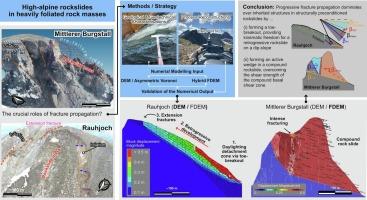The critical role of fracture propagation in the evolution of extensive, structurally preconditioned rockslides
IF 8.4
1区 工程技术
Q1 ENGINEERING, GEOLOGICAL
引用次数: 0
Abstract
The inherited rock mass structure often preconditions rockslides in foliated, metamorphic rock slopes. However, the role of progressive fracturing processes associated with rock slope failure is receiving increasing attention. This paper demonstrates how rock mass fracturing can overcome limitations imposed by the inherited rock mass structure in two high-alpine rockslides with volumes of 670,000 and 1,000,000 m3, applying a comprehensive methodological approach.
The rockslides' evolution and kinematics are unravelled based on remote sensing campaigns. Geological-geotechnical field and laboratory investigations provide the basis for a complementary numerical approach, utilising discrete-element (DEM) and hybrid-finite-discrete-element (FDEM) models. Leveraging the potential of each numerical approach, the rockslides are back-analysed, investigating the role of inherited structures and fracture propagation in the rockslides' evolution.
The inherited structures, particularly foliation layers and tectonic shear zones, strongly precondition both rockslides while imposing specific limitations on their initiation. Nonetheless, progressive fracture propagation overcomes these structural limitations by (i) developing a toe-breakout that provides kinematic freedom for a retrogressive rockslide on a dip-slope, and (ii) forming an active wedge in a compound rockslide, which overcomes the frictional resistance of a tectonically preconditioned basal shear zone. Furthermore, the (iii) complementary DEM-FDEM approach showcases the advantages of each respective method and reproduces these fracturing processes in remarkable agreement with field observations, holding significant implications for engineering geology and hazard assessment. Thus, this study demonstrates that even in structurally preconditioned rockslides, progressive fracture propagation can dominate over inherited structures in controlling the mechanism and evolution of large rockslides.

裂缝扩展在广泛的、结构预置的滑岩演化中的关键作用
在片理变质岩坡中,继承的岩体结构往往是滑坡的先决条件。然而,与岩质边坡破坏相关的渐进压裂过程的作用正受到越来越多的关注。本文运用综合的方法方法,论证了67万和100万立方米两个高高山滑坡岩体压裂如何克服继承岩体结构的限制。基于遥感活动揭示了滑坡的演化和运动学。地质-岩土工程现场和实验室调查为利用离散元(DEM)和混合有限-离散元(FDEM)模型的互补数值方法提供了基础。利用每种数值方法的潜力,对滑坡进行反向分析,研究继承结构和裂缝扩展在滑坡演变中的作用。继承的构造,特别是片理层和构造剪切带,是两种滑坡的先决条件,同时也对它们的发生施加了特定的限制。尽管如此,渐进式裂缝扩展通过以下方式克服了这些结构上的限制:(1)形成一个脚趾突破,为倾斜斜坡上的后退性岩石滑坡提供运动自由;(2)在复合岩石滑坡中形成一个活动楔,克服了构造预先调节的基底剪切带的摩擦阻力。此外,(iii)互补的DEM-FDEM方法展示了每种方法的优势,并与现场观察结果非常一致地再现了这些压裂过程,对工程地质和危害评估具有重要意义。因此,本研究表明,即使在结构预置的滑坡中,渐进式断裂扩展在控制大型滑坡的机制和演化方面也可能优于继承结构。
本文章由计算机程序翻译,如有差异,请以英文原文为准。
求助全文
约1分钟内获得全文
求助全文
来源期刊

Engineering Geology
地学-地球科学综合
CiteScore
13.70
自引率
12.20%
发文量
327
审稿时长
5.6 months
期刊介绍:
Engineering Geology, an international interdisciplinary journal, serves as a bridge between earth sciences and engineering, focusing on geological and geotechnical engineering. It welcomes studies with relevance to engineering, environmental concerns, and safety, catering to engineering geologists with backgrounds in geology or civil/mining engineering. Topics include applied geomorphology, structural geology, geophysics, geochemistry, environmental geology, hydrogeology, land use planning, natural hazards, remote sensing, soil and rock mechanics, and applied geotechnical engineering. The journal provides a platform for research at the intersection of geology and engineering disciplines.
 求助内容:
求助内容: 应助结果提醒方式:
应助结果提醒方式:


